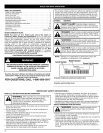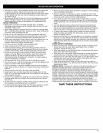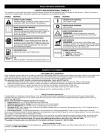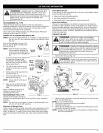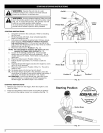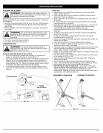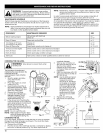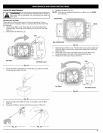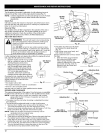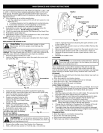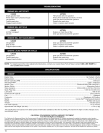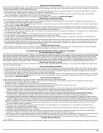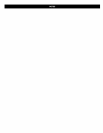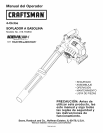
WARNING:Topreventseriousinjury,neverperform
maintenanceorrepairswithunitrunning.Alwaysservice
andrepairacoolunit.Disconnectthesparkplugwireto
ensurethattheunitcannotstart.
MAINTENANCE SCHEDULE
Perform these required maintenance procedures at the frequency
stated in the table. These procedures should also be a part of any
seasonal tune-up.
NOTE: Some maintenance procedures may require special tools or
skills. Ifyou are unsure about these procedures take your unit
to a Sears or other qualified service dealer.
NOTE: Maintenance, replacement, or repair of the emission control
devices and system may be performed by a Sears or other
qualified service dealer.
In order to assure peak performance of your engine, inspection of
the engine exhaust port may be necessary after 50 hours of
operation. If you notice lost RPM, poor performance or general lack
of acceleration, this service may be required. If you feel your engine
is in need of this inspection, refer service to a Sears or other
qualified service dealer for repair. DO NOT attempt to perform this
process yourself as engine damage may result from contaminants
involved in the cleaning process for the port.
FREQUENCY MAINTENANCE REQUIRED SEE
Before starting engine Fill fuel tank with fresh fuel p. 7
Check oil p. 10
Every 10 hours Clean and re-oil air filter p. 11
1st change at 10 hours Change oil p. 10
2nd change at 40 hours Change oil p. 10
Every 40 hours after Clean spark arrestor and change oil p. 13 & 10
10 hours on new engine Check rocker arm to valve clearance and adjust p. 12
Every 40 hours Check rocker arm to valve clearance and adjust p. 12
Every 40 hours Check spark plug condition and gap p. 13
200 hours Take unit to a Sears or other qualified service center for service
CHECKING THE OIL LEVEL
WARNING: Wear gloves to prevent injury when
handling unit.
The importanceof checking and
maintaining the proper oil level inthe
crankcase cannot be
r
overemphasized. Check oil before 4
each use: _"
1. Stop the engine and allow
U
oil to drain into the
crankcase.
2. Place the engine on a level
surface (Fig. 16).
3. Clean the area around the oil
plug before removing it. Keep |
dirt, grass clippings, and other
debris out of the engine.
4. Remove the oil fill plug.
5. Look into the oil fillhole (use a
flashlight if needed). The oil
should be just touching the
innermost thread (Fig. 17).
6. If the oil level is not touching the
innermost thread on the oil fill hole,
add a small amount of oil to the oil
fill hole and recheck (Fig. 17).
Repeat this procedure until the oil
level reaches the innermost thread
on the oil fill hole.
NOTE: Do not overfill the unit.
NOTE: Make sure the O-ring is in place
on the oil fill plug when checking
and changing the oil (Fig. 18).
CHANGING THE OIL
Fig. 16
Innermost
Thread
Oil Fill
Hole
-- Fig. 17
For a new engine, change the oil after the first 10 hours of operation.
Change the oil while the engine is still warm. The oil will flow freely
and carry away more impurities.
1. Remove the oil fill plug.
2. Pour the oil out of the oil fill hole and into a container by tipping
the unit to a vertical position (Fig. 19). Allow ample time for
complete drainage.
3. Wipe up any oil residue on
the unit and clean up any oil
that may have spilled.
Dispose of the oil according
to Federal, State and local
regulations.
4. Refill the crankcase with 2.03
fluid ounce (60 ml) of SAE 30
SF, SG, SH oil.
NOTE: Use the bottle and spout
saved from initial use to
measure the correct
amount of oil. The fill line
on the label on the bottle
measures approximately
2.03 ounces (60 ml) (Fig.
20). Check the level, See
Checking the Oil Level. If
the level is low, add a
small amount of oil and
recheck. Do not overfill
(Fig. 17).
5. Replace the oil fill plug.
6. Reconnect the spark plug
boot.
Fig. 20
Oil Fill Plug _'_ _ _
°1'
Fig. 18
Fig. 19
Fill Level
I 4-Cyde Motor Oil
Fill Line
-L
10



